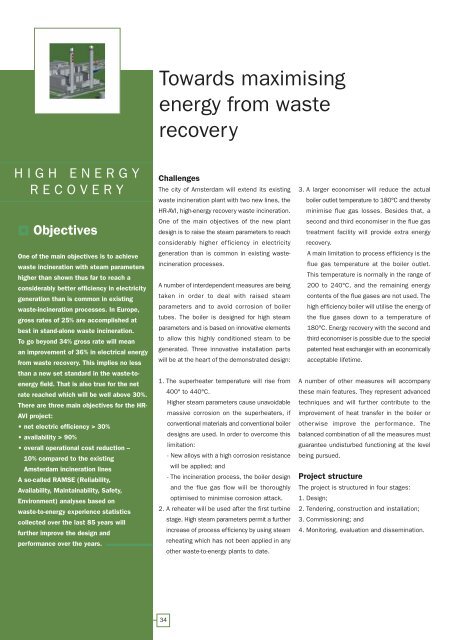European Bio-Energy Projects
European Bio-Energy Projects
European Bio-Energy Projects
You also want an ePaper? Increase the reach of your titles
YUMPU automatically turns print PDFs into web optimized ePapers that Google loves.
HIGH ENERGY<br />
RECOVERY<br />
Objectives<br />
One of the main objectives is to achieve<br />
waste incineration with steam parameters<br />
higher than shown thus far to reach a<br />
considerably better efficiency in electricity<br />
generation than is common in existing<br />
waste-incineration processes. In Europe,<br />
gross rates of 25% are accomplished at<br />
best in stand-alone waste incineration.<br />
To go beyond 34% gross rate will mean<br />
an improvement of 36% in electrical energy<br />
from waste recovery. This implies no less<br />
than a new set standard in the waste-toenergy<br />
field. That is also true for the net<br />
rate reached which will be well above 30%.<br />
There are three main objectives for the HR-<br />
AVI project:<br />
• net electric efficiency > 30%<br />
• availability > 90%<br />
• overall operational cost reduction –<br />
10% compared to the existing<br />
Amsterdam incineration lines<br />
A so-called RAMSE (Reliability,<br />
Availability, Maintainability, Safety,<br />
Environment) analyses based on<br />
waste-to-energy experience statistics<br />
collected over the last 85 years will<br />
further improve the design and<br />
performance over the years.<br />
Towards maximising<br />
energy from waste<br />
recovery<br />
Challenges<br />
The city of Amsterdam will extend its existing<br />
waste incineration plant with two new lines, the<br />
HR-AVI, high-energy recovery waste incineration.<br />
One of the main objectives of the new plant<br />
design is to raise the steam parameters to reach<br />
considerably higher efficiency in electricity<br />
generation than is common in existing wasteincineration<br />
processes.<br />
A number of interdependent measures are being<br />
taken in order to deal with raised steam<br />
parameters and to avoid corrosion of boiler<br />
tubes. The boiler is designed for high steam<br />
parameters and is based on innovative elements<br />
to allow this highly conditioned steam to be<br />
generated. Three innovative installation parts<br />
will be at the heart of the demonstrated design:<br />
1. The superheater temperature will rise from<br />
400° to 440°C.<br />
Higher steam parameters cause unavoidable<br />
massive corrosion on the superheaters, if<br />
conventional materials and conventional boiler<br />
designs are used. In order to overcome this<br />
limitation:<br />
- New alloys with a high corrosion resistance<br />
will be applied; and<br />
- The incineration process, the boiler design<br />
and the flue gas flow will be thoroughly<br />
optimised to minimise corrosion attack.<br />
2. A reheater will be used after the first turbine<br />
stage. High steam parameters permit a further<br />
increase of process efficiency by using steam<br />
reheating which has not been applied in any<br />
other waste-to-energy plants to date.<br />
34<br />
3. A larger economiser will reduce the actual<br />
boiler outlet temperature to 180°C and thereby<br />
minimise flue gas losses. Besides that, a<br />
second and third economiser in the flue gas<br />
treatment facility will provide extra energy<br />
recovery.<br />
A main limitation to process efficiency is the<br />
flue gas temperature at the boiler outlet.<br />
This temperature is normally in the range of<br />
200 to 240°C, and the remaining energy<br />
contents of the flue gases are not used. The<br />
high efficiency boiler will utilise the energy of<br />
the flue gases down to a temperature of<br />
180°C. <strong>Energy</strong> recovery with the second and<br />
third economiser is possible due to the special<br />
patented heat exchanger with an economically<br />
acceptable lifetime.<br />
A number of other measures will accompany<br />
these main features. They represent advanced<br />
techniques and will further contribute to the<br />
improvement of heat transfer in the boiler or<br />
otherwise improve the performance. The<br />
balanced combination of all the measures must<br />
guarantee undisturbed functioning at the level<br />
being pursued.<br />
Project structure<br />
The project is structured in four stages:<br />
1. Design;<br />
2. Tendering, construction and installation;<br />
3. Commissioning; and<br />
4. Monitoring, evaluation and dissemination.

















